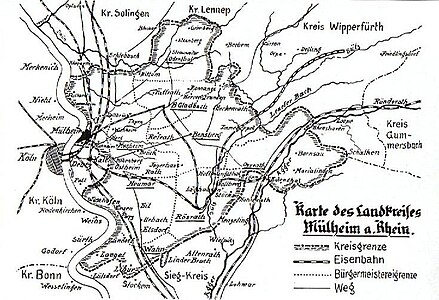Mayor's office of Gladbach
The mayor's office in Gladbach was one of nine mayor's offices in the district of Mülheim am Rhein in the administrative district of Cologne in the Prussian Rhine province . It was created in 1816 from the Mairie Gladbach , which was built by the French in the Grand Duchy of Berg .
Due to the Rhenish city code , the mayor's office was granted city rights on August 9, 1856 and was allowed to call itself the city of Gladbach. The name of the city and mayor's office was changed to Bergisch Gladbach in 1863 to avoid confusion with Munich Gladbach .
With the Prussian law regulating various points of the municipal constitutional law of December 27, 1927, the mayor's offices were finally abolished and the city of Bergisch Gladbach lost the parallel status of mayor's office.
location
The mayor's office was in the northern half of the district. In the north it bordered the Odenthal mayor and, further clockwise, the Wipperfürth district , the Bensberg mayor and the Merheim mayor . The size was 3,121 ha in 1920 .
Infrastructure
On supraregional roads there was the old Wipperfürther Straße, today's federal highway 506 and old Heerstraße from Cologne via Gladbach to Wipperfürth and the provincial road Mülheim -Gladbach Spitze , which was completed by Gladbach in 1842 and byspitze in 1848.
Gladbach had a train station in Gronau on the Cologne-Mülheim-Lindlar line . In 1906 the connection to the Cologne tram was added.
Since 1842, Gladbach had a post office and a post office (class III until 1879, class II until 1901, then class I). The postal agencies in Altenberg , Bechen , Dürscheid , Herrenstrunden , Odenthal and Paffrath were subordinate to him .
Municipalities and localities
1828 belonged to the mayor's three knights seats and estates, two domain goods , 94 farmsteads and 16 consisting of individual houses districts .
In detail:
Gladbach
The parish Gladbach with the Protestant parsonage and schoolhouse whorl , the Catholic parsonage and schoolhouse horse, the paper mills to Gladbach and Gronau, the paper mill dump mill , the cloth fulling mill and wool spinning punch mill , the farmsteads Mountain , Kamp , Bonnschlade , Kradepohl , Driesch , Duckterath , Dünnhof , Eicherhof , Frohnhof , Gierath , abomination , Unter lückerath , pit , Heiden, Heidkamp , hut, Mohnshäuschen , Jüch , Kaule, Leimkaul, Letsch, Linden, Neuenborn, Beningsfeld , Piddelborn , Reif, Rodenbach , Schreibersheide , Schornhäuschen, Schmitsberg, Schlom, winners Kamp, Obersteingaß, stein, Strüchen, Strundorf, full mill , calves, meadows , Schlodderdich and the taverns Bock, Buchenmuhle and Waatsack and a general store Bergers house. This corresponds to the former Bergisch honors Gladbach and Gronau .
Paffrath
The parish of Paffrath with the village of Paffrath with a parish church and a mill, the knight's seat Haus Blegge , the farms Apenschoss, Bach, Blakenbroich, Borsbach (today Unterboschbach ), Broch, Büchel , Büchel, Dreck , Combüche , Eichen , Flachsberg , Geisbock , Hoppersheide , Hebborn , Heide , Heidgen , Holz (today Unter- and Oberholz ), Höffen , Hülsen , Katterbach , Kamp , Kämperfeld , Kittelburg , Kley , Kuckelberg , Kuhle , Mutz , Nussbaum , Platz, Pohl , Romaney , Risch , Rommerscheid , Rosenthal , Schneprad , Schüllenbusch , Siefen , Siefen, Sehlscheid (today Seelsheide ), Untersteingaß, Steinknippen , Sträßchen Siefen , Torringen , Vorend , Weihpütz, the hammer mill and the Burg tavern . This corresponds to the honors Paffrath and Combüche .
sand
The parish sand with the estate Igel , the knight seat Lerbach , domain goods Bliss Hof and Oberthal , the two paper mills Dombach, the two powder mills ship that Pottaschsiederei Schmitz Heide , the farmsteads Dombach , Heiden, Herrig, cold Broich , Meiswinkel , Rommerscheid , Weyermühle and Pastorate Sand with the parish church. This corresponds to sand .
In 1859, the villages from the former Obersand exclave of the Honschaft Sand, which until then belonged to the municipality of Sand, came to the parish of Dürscheid and the mayor's office of Bensberg . These are the villages of Blissenbacher Hof , Weyermühle , Hauserhof and Meiswinkel . Oberlückerath and Beningsfeld also came from the city of Gladbach to Bensberg. Herrenstrunden , Trotzenburg and Unterthal , however, came to the mayor's office in Gladbach.
Furthermore, the Hofstellen Hand (parish Paffrath) Oberlückerath (parish Bensberg ) and the Mahlmühle Diepeschrath (parish Dünnwald ) belonged to the mayor's office.
Overall, this corresponds to the Gladbach messenger office .
literature
- Johann Bendel: Homeland book of the district of Mülheim am Rhein. History and description, sagas and tales . Facsimile print of the 2nd and 3rd edition Cologne-Mülheim 1925. Cologne 1981. ISBN 3-921232-05-8
Individual evidence
- ^ Friedrich von Restorff: Topographical-statistical description of the Royal Prussian Rhine Provinces , Berlin and Stettin, 1830
- ^ Anton Jux: The Bergische Botenamt, the history of Bergisch Gladbach up to the Prussian period , published by the cultural office of the city of Bergisch Gladbach, Bergisch Gladbach 1964
- ^ Albert Esser (ed.): Bergisch Gladbacher Stadtgeschichte . City Archives Bergisch Gladbach, 2006.

